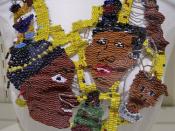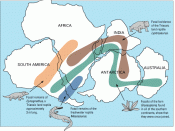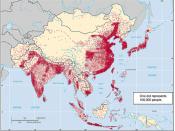The land below us is always in motion. Plate tectonics studies these restless effects to give us a better understanding of the Earth and its past. New molten rocks are poured out in the form of magma from the mid-ocean ridges. The rock is recycled and re-entered back into the earth in deep ocean trenches through convection current. The convection current in the mantle drives plates around either against or away from each other. These collisions give rise to earthquakes, volcanoes, mountains, and continental drift. The crashing and spreading of the plates forms the landscape of the Earth as we see it today. The positions of the land masses today is a result of continental drift. During the Earth's existance, the magnetic fields have never been stable. Solidified magma containing magnetic imprints reveal periods of time when the Earth's magnetic fields have actually been reversed.
Approximately 4.55 billion years ago, the Earth was just a ball of molten material.
Since then, parts of the Earth have cooled forming the solid crust-mantle. This process has been occurring for roughly about 3.8 billion years. The mantle is about 2900 km. thick, which lies above a layer of molten magma that still exists today. The immense heat from the magma (approximately 2700(C) causes convection in the mantle (Figure 1). Convection is caused by non-uniform temperature in a fluid and density differences. This continuous convection is the cause of plate movement. Each complete cycle, called a convection cell, drives the plate in the direction of the cell. How does a 'solid' mantle move? The mantle may be solid but, as with most solids, it will deform if long term stress is applied; '...like Silly Putty which seeps into the rug when left unattended, mantle material flows when subjected to small long-term stresses.'1
Presently, there...


